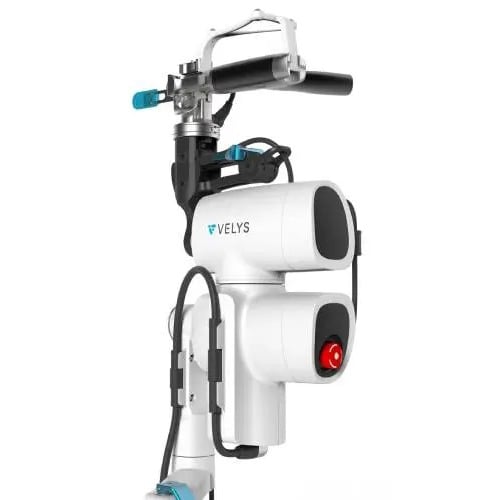VELYS Digital Surgery by DePuy Synthes, is a robotic-assisted surgical system that attaches to the operating table bedside and is used for accurate and precise knee-replacement surgeries. Since the VELYS system mounts on the operating table, it is easily positioned by the orthopedic surgeon.
What is the VELYS robotic-assisted surgical system?
VELYS, pronounced vell-iss, provides continuous real-time feedback to the surgeon throughout the procedure using AI technology to guide and map where a surgeon should remove bone, resulting in an efficient surgical experience and a long-lasting implant. When paired with a skilled surgical team, this tool is an extra set of magnified eyes.
VELYS’s high-speed optical tracking system takes 300 images per second, capturing the surgeon’s slightest movement, for remarkably precise imaging. The joint’s position is reassessed before the implant is permanently positioned to ensure balanced tension in the knee throughout the range of motion.
At Pullman Regional Hospital’s Orthopedic Center of Excellence, orthopedic surgeons Dr. Ed Tingstad and Dr. Mat Taylor use the VELYS system for knee replacement surgeries. VELYS surgeries come at no additional cost to knee replacement patients.
“The VELYS system is world-class. It, coupled with the talented and seasoned operating room team at Pullman Regional Hospital, create a surgical experience that rivals anywhere,” says Dr. Tingstad. “You don’t have to go to Seattle for the best surgical team or technology; you can get that right here in Pullman.”
Who is a good candidate for VELYS?
One of the benefits of VELYS robotic-assisted knee replacement surgery is that it can be calibrated to fit the exact anatomical structure of each person’s individual knee. That being said, there are some factors that go into determining if a robotic-assisted knee replacement is the best option for you. You and your orthopedic surgeon will look at factors such as your activity level, weight, bone density, and more to determine the best surgical option for you.
“Not every patient needs surgery. As doctors, it’s our job to look at all the options to help our patients have a better quality of life,” shares Dr. Tingstad.
If you have questions about VELYS or want to know if you’re a good candidate, speak to your orthopedic surgeon or ask your primary care provider for a referral to Inland Orthopaedics, part of the Pullman Regional Hospital Orthopedic Center of Excellence.
When is it time to consider a total joint replacement surgery?
If you’re finding it painful or difficult to do tasks you used to do easily, it’s always a good idea to talk to your primary care provider. “I love seeing patients get back to their life,” shares Dr. Taylor. “Joint pain can be so debilitating. It can really prevent people from doing the things they want to do, especially in these golden years where they've worked their entire life to save up to do the things they want to do and see. Witnessing them not able to do that because of pain is so heartbreaking. I love when they're able to get back to their life, take that vacation they’ve planned, visit their grandkids and just enjoy moving without pain.”
Sometimes people to put off joint replacement procedures due to concerns about long hospital stays and difficult recovery periods. At Pullman Regional Hospital, joint replacement patients typically stay 1 night in the hospital, though each individual’s circumstances may require more or less time. “Infection rates at Pullman Regional Hospital are extremely low, which is important because these type of procedures are often challenging to recover from, and you don’t want the complication of an infection,” says Dr. Tingstad.
Why robotic-assisted surgery?
There are many different kinds of robotic-assisted surgical systems that are used in a variety of different procedures like joint replacements, hernia repairs, vasectomies and hysterectomies.
In orthopedics, robotic-assisted surgical systems provide both the surgeon and the patient peace of mind by calculating exact measurements, cut lines, and implant sizes. “The VELYS robotic-assisted surgical system is more precise than the human eye,” says Dr. Tingstad.
The knee is the most arthritic joint in the body. Dr. Tingstad says he anticipates a 500% increase in total knee replacement surgeries in the next 15 years. This means an exact fit is crucial—your surgeon wants this to last. Fortunately, the team at Pullman Regional Hospital has a lot of experience with total knee replacements; Dr. Tingstad does about 100 knee replacement procedures each year.
Robotic-assisted surgery also means smaller incisions. The surgical instruments the robotic system uses are easily moved and manipulated by the surgeon with greater range of motion than the human wrist. Not only are incisions smaller, but there is less trauma on the body, since a smaller area is affected during the procedure. This means a faster and less painful recovery period after surgery.
Where can I learn more about VELYS and total joint replacement surgeries?
Pullman Regional Hospital’s Orthopedic Center of Excellence has a dedicated Orthopedic Care Coordinator, Maile Keller, PTA, to answer questions, provide information to patients considering a total joint replacement surgery, and help guide patients through the surgical process.
Maile Keller has over 20 years of experience taking care of total joint replacement patients, so she knows how to make the surgical experience as seamless as possible. Send Maile an email, or reach her by phone at (509) 336-7598 if you’re considering a total joint replacement surgery.
Patients who have scheduled their total joint replacement surgery and those interested in doing so are encouraged to attend one of Pullman Regional Hospital’s Total Joint Replacement Preparation Classes. The class will teach you how to prepare for your surgery to achieve the best outcome, and what you can expect after surgery and during rehabilitation. You’ll also have a chance to speak with representatives from different hospital departments like pharmacy, nutrition, patient financial services, and physical therapy to learn specifics on how much your surgery could cost, what types of medications you’ll be prescribed and more.
You May Also Enjoy:
